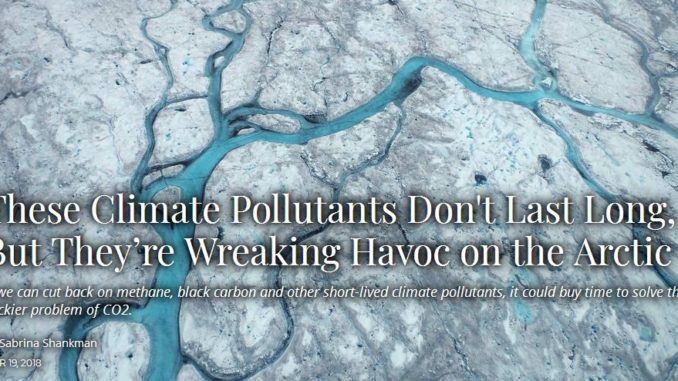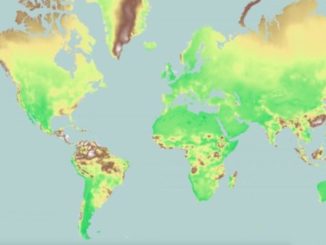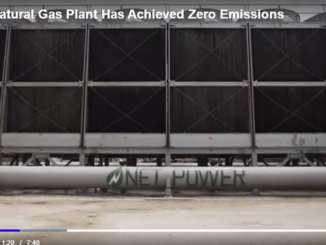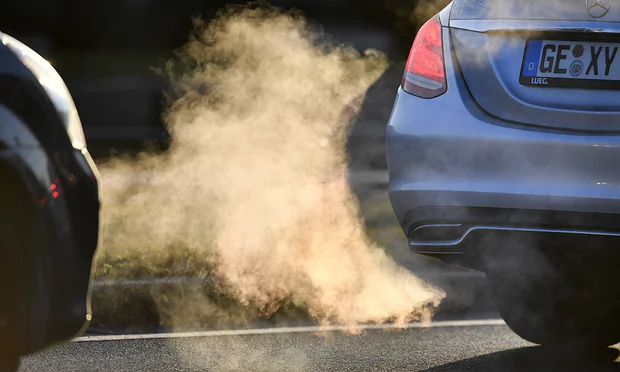
If we can cut back on methane, black carbon and other short-lived climate pollutants, it could buy time to solve the trickier problem of CO2.
By Sabrina Shankman
MAR 19, 2018
When people talk about climate change, the focus is often on carbon dioxide, and for good reason. The CO2 pumped into the atmosphere by burning fossil fuels today will hang around for centuries, building up over time and continuing to warm the planet.
It isn’t the only culprit, though. Mixing in are other pollutants that only stick around for a few weeks or years but pack a powerful punch while they’re there. And the Arctic, where the average temperature is rising twice as fast as the rest of the world, has become the unfortunate laboratory where researchers can best measure their impact.
The role that short-lived climate pollutants play in the Arctic has repercussions, because what happens in the Arctic affects the entire planet.
Tackling the problems raised by these potent pollutants—methane, black carbon, tropospheric ozone and hydrofluorocarbons (HFCs) chief among them—offers a glimmer of opportunity for saving the rapidly warming Arctic. If they can be significantly reduced, the impact will be felt almost immediately, giving countries much needed time to solve the trickier problem of CO2.
“The hope is that we can buy time by reducing short-lived climate forcers,” said Patricia Quinn, an atmospheric chemist researching these pollutants at the National Oceanographic and Atmospheric Administration (NOAA).

Ships enter Russia’s Kara Sea port of Sabetta, where Yamal LNG opened a liquefied natural gas plant in 2017. In the Arctic, two-thirds of black carbon comes from heavy fuel oil, which is used in shipping. Natural gas and oil operations contribute methane. Credit: Kirill Kudyavtsev/AFP/Getty Images
Ice that blankets the Arctic region reflects the sun’s rays and helps regulate the Earth’s climate. But as temperatures rise and sea ice levels drop to record lows, more of the dark ocean is exposed, and the sun’s warmth is absorbed instead of reflected. The warming leads to more warming, which leads to more warming—and so on.
In this chain reaction, the jet stream can shift, affecting weather everywhere. Higher temperatures thaw the permafrost, releasing unknown amounts of methane as generations of frozen plants and organic materials begin to decompose. Then there’s the potential for zombie diseases, dormant for millennia, to see new life, and for the melting of glaciers to raise sea level.
Save the Arctic, and we might just save ourselves.

A UCLA research team takes measurements in Greenland, where soot has darkened the ice in some areas, contributing to melting. Credit: Mia Bennett/Cryopolitics
The Arctic Council, an intergovernmental body that represents the eight Arctic nations and indigenous groups, has emphasized reducing black carbon and methane.
Mikael Hilden, who leads the council’s Expert Group on Black Carbon and Methane, said that by getting stakeholders to agree on reductions in these critical pollutants, change is possible. “It’s a relatively rapid action that you can see the results quite quickly,” he said.
With that in mind, here’s a breakdown of the big short-lived climate pollutants, and how they wreak havoc in the environment:
Methane
Methane, the second most prominent greenhouse gas after carbon dioxide, is far less prevalent than CO2—but in the short-term, it packs a bigger punch. In the comparatively brief time that methane is in the atmosphere, it warms the planet about 86 times as much as the same amount of CO2, according to the Intergovernmental Panel on Climate Change.
Methane levels have doubled since the preindustrial era, trapping more heat in the atmosphere and re-radiating it back to earth. In the Arctic, that melts sea ice, thaws permafrost and disrupts global weather patterns.

Roughly two-thirds of methane comes from manmade sources like the oil and gas industry (oil extraction and leakage in natural gas systems), agriculture (manure pits and cow belches) and landfills. It also has natural sources, like wetlands and thawing permafrost.
As global methane levels have increased, the impact has been felt twice as much in the Arctic, about a half a degree Celsius more of Arctic warming, according to climate models.
Methane stays in the atmosphere for about nine years. That’s long enough to become mixed throughout the atmosphere (so what’s emitted in Texas impacts the Arctic) but short enough that cutting back methane emissions could have a telling, near-term impact.
The good news about methane is there are already pretty clear paths to progress, explained Jonathan Banks, senior climate policy advisor for the Clean Air Task Force. “None of this is rocket science,” he said. “This isn’t finding a way to harness moon power. These are things that we know how to do.”
For oil and gas operations, those things include tightening valves on oil and gas operations, replacing equipment before it wears out, or making sure all of the gas makes it into the pipeline.
Obama-era rules to cut methane emissions from oil and gas operations on public lands are in the crosshairs of the Trump administration. And, although countries around the globe tackle greenhouse gas emissions, methane emissions have spiked. In 2014, methane concentrations rose 12.5 parts per billions, and in 2015, they rose 9.9 parts per billion (by comparison, a decade ago, they were rising at a rate of about 0.5 parts per billion annually).

At the same time, warming in the Arctic is leading to a worrisome feedback loop. As temperatures rise, permafrost thaws, unleashing trapped methane into the atmosphere and leading to more warming. Scientists are working to figure out just how much methane is in the permafrost—suffice it to say, it’s a lot.
Black Carbon
Unlike greenhouse gases, black carbon is a climate forcer you can see and feel. Not only does it warm the atmosphere by absorbing sunlight—it’s also dark soot that’s deposited onto ice and snow, speeding up the melting.
Black carbon stays in the atmosphere for just days to weeks, but it can do a lot of lasting damage. The contribution to warming by one gram of black carbon is 100 to 2,000 times more than one gram of CO2 on a 100-year timescale. A 2011 study by scientists from NASA’s Goddard Institute for Space Studies found that as much as a quarter of Arctic warming is caused by black carbon. Another 2015 study found that, like methane, black carbon is responsible for about a half a degree Celsius of warming in the Arctic.
“Controlling black carbon may be the only way of preventing the loss of the Arctic completely,” said Mark Jacobson, an atmospheric scientist who researches air pollution and climate change at Stanford University.

Black carbon comes from natural sources like forest fires and is also driven by human activities like the production or burning of fossil fuels, biofuels and biomass. Wood burning, diesel engines and cook stoves are also big sources. What all these have in common is inefficient combustion—the type that creates black, particle-filled smoke.
Black carbon impacts climate in a number of ways, some of which scientists are still trying to understand. Its impact depends on where the black carbon is. In the atmosphere and on the snow and ice, it absorbs sunlight and increases warming. But while it’s airborne, black carbon can interact with clouds in various ways. Sometimes it causes clouds to evaporate, which leads to further warming, but sometimes it helps clouds form, which can help block incoming sunlight and cool the planet.
Black carbon can be transported to the Arctic from more populated and industrial areas further south, but local emissions also make a big difference. About a third of Arctic warming traced to black carbon is from emissions from Arctic countries.

Flaring of natural gas—more commonplace in the Arctic where there is less available infrastructure to capture and transport natural gas associated with oil drilling—can be a major source. A 2013 study in the journal Atmospheric Chemistry and Physics found that that gas flaring contributes less than 3 percent of global black carbon emissions globally, but flaring in the Arctic contributes 42 percent of black carbon found on the ground.
As the Trump administration advances plans to open up the Arctic National Wildlife Refuge and the offshore waters of Alaska to drilling—and as decreasing sea ice increases options of Arctic drilling—that could mean an increase in black carbon.
Less ice in the Arctic will lead to more ship traffic on formerly ice-clogged routes. As shipping increases, so will emissions from heavy fuel oil—known as bunker fuel—that powers most of the region’s ships. In 2010, the International Maritime Organization outlawed the thick fuel in Antarctica, but it is still allowed in the Arctic.
Global black carbon emissions have stopped rising, thanks in part to the adoption of energy-efficient technologies. But there’s more that can be done. Hilden and his colleagues with the Arctic Council hope to see further technological advances coupled with tighter limits on emissions.
Clean technology for small-scale burning of firewood could drastically decrease black carbon emissions, as would forest fire prevention and stricter limits on oil and gas flaring.
“My hunch is that there’s a need for the political pressure to make the industry innovate,” Hilden said.
Tropospheric Ozone
In the upper atmosphere, ozone is a good thing. It forms a natural shield that absorbs the sun’s ultraviolet radiation and helps keep the Earth hospitable. Hence the successful global effort to stop the manmade ozone hole from endangering life on the planet.
But in the lower level—called the troposphere—manmade ozone is a greenhouse gas and short-lived climate pollutant that enhances global warming.
Tropospheric ozone is created when the sun interacts with methane, nitrogen oxides, volatile organic compounds (VOCs) and carbon monoxide in the atmosphere. Those precursor gases come from manmade sources like fossil fuel combustion and production, biofuel combustion, industrial processes and biomass burning. They’re also caused by wildfires, natural emissions from soils and vegetation, and lightning.
“Ozone is the third most important greenhouse gas after CO2 and methane,” said Owen Cooper, a senior research scientist working at NOAA’s Boulder Labs in the Chemical Sciences Division.
Its impact is more significant at lower latitudes, especially the tropics and subtropics. But ozone is also problem for the Arctic. In Utqiagvik, Alaska (formerly known as Barrow)—one of a handful of stations where NOAA measures Arctic ozone levels—there’s been a 12 percent increase in average ozone levels since measurement began 45 years ago, Cooper said.

“We see a lot of wildfire influences in the summertime, which will drive high ozone,” said Audra McClure-Begley, a University of Colorado scientist working at NOAA. “In the winter, there’s a buildup of transported pollution from more populated regions in Asia, which is really known as Arctic haze.”
And, as more ships traverse the Arctic, local sources of ozone may play a greater role. A 2006 study in the journal Atmospheric Chemistry and Physics found that an increase in shipping could cause surface ozone levels to double or triple in the summer time, compared with the early 2000s.
Hydrofluorocarbons (HFCs)
These pollutants represent an unintended side-effect of solving a problem.
In the mid-1900s, scientists realized that compounds being used as coolants in refrigerators and air conditioners and as a propellant in foams—called chlorofluorocarbons (CFCs)—were also destroying the ozone layer.
In 1987, with the signing of the Montreal Protocol, a massive international effort to phase out ozone-depleting substances was launched. Nearly 200 countries ratified the agreement, and it has been hailed as the world’s most successful environmental agreement. Unfortunately, what replaced CFCs—hydrofluorocarbons (HFCs)—came with their own host of problems.
HFCs may not have the same impact on the ozone layer, but they are potent contributors to climate change. A so-called super greenhouse gas that can live in the atmosphere for an average of 14 years, they are between 1,000 and 3,000 times stronger than CO2.
Though they are considered short-lived climate pollutants, they are in the atmosphere long enough to become generally mixed, much like methane. “They’re pretty evenly distributed across the atmosphere,” said Stephen Montzka, a NOAA scientist who monitors global changes in HFCs and studies their radiative forcing effects over time.
An update to the Montreal Protocol, called the Kigali Amendment, agreed on in 2016, requires all countries to slash production and consumption of HFCs by at least 80 percent over the next 30 years. The stakes for full implementation are high—the agreement is expected to prevent up to 80 billion tonnes of CO2 equivalent emissions by 2050, which could prevent up to 0.5 degrees Celsius in warming.
Sulfate
Unlike other short-lived climate pollutants, sulfate presents a different climate-change pickle: the more sulfate in the Earth’s atmosphere, the cooler the planet.
“It can reflect incoming surface radiation and cool the surface,” said NOAA’s Patricia Quinn. Thus it can mask the full impact that greenhouse gas emissions have on climate change by temporarily negating some of the warming.

Sulfate is emitted along with other pollutants when fuels are burned. So as Europe and the United States have tightened air quality standards and cleaned up emissions from power plants, sulfates in the atmosphere have been reduced as well.
A 2016 study in the journal Nature Geoscience found that sulfate aerosol reductions in Europe since 1980 could account for as much as a half-degree Celsius of warming observed in the Arctic between 1980 and 2005.
And in the future, as countries eliminate the use of fossil fuels to stave off global warming, the decline in sulfate could have a big impact, offsetting part of the progress.
A 2017 study in the American Meteorology Society’s Journal of Climate found that if countries meet the overall goal of keeping warming below 2 degrees Celsius via the “maximum technically feasible” cuts in fossil fuel use, the Arctic could see .84 degrees Celsius in warming by the middle of the century as sulfate decreases. The warming from sulfate would partly offset the downward temperature trend that would come from the decline in greenhouse gas emissions.
“It’s kind of a conundrum,” said Quinn.
But the net benefits of reducing air pollution far outweigh the loss of sulfate’s cooling properties. “I don’t think that we purposely want to stop cleaning up our emissions. I think it’s just having to be aware of it and putting it into the models.”
Top photo: While rivers of meltwater wind across the Greenland ice sheet, a windblown dust of soot, small rock particles and bacteria darkens areas on the ice. Credit: Mia Bennett/Cryopolitics
Visits: 51




Be the first to comment